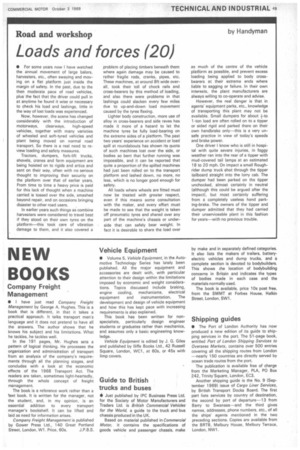Road and workshop
Page 55

If you've noticed an error in this article please click here to report it so we can fix it.
Loads and forces (20)
by Handyman
• For some years now I have watched the annual movement of large balers, harvesters, etc., often swaying and moving on a flat platform just inside the margin of safety. In the past, due to the then moderate pace of road vehicles, plus the fact that the driver could pull in at anytime he found it wise or necessary to check his load and lashings, little in the way of lost loads was experienced.
Now, however, the scene has changed considerably with the introduction of motorways, clearways, high-speed vehicles, together with many varieties of wheeled and sott-tyred vehicles and plant being moved on normal road transport. So there is a real need to review loading and safety measures.
Tractors, dumpers, fork-lift trucks, shovels, cranes and farm equipment are being hoisted on to rigids and artics and sent on their way, often with no serious thought to improving their security on the platform over that of earlier years. From time to time a heavy price is paid for this lack of thought when a machine carried is tossed over the side, smashed beyond repair, and on occasions bringing disaster to other road users.
In earlier years such things as combine harvesters were considered to travel best if they stood on their own tyres on the platform—this took care of vibration damage to them, and it also covered a problem of placing timbers beneath them where again damage may be caused to rather fragile rods, cranks, pipes, etc. These machines, at around 8ft wide overall, took their toll of chock rails and cross-bearers by this method of loading, and also there were problems in that lashings could slacken every few miles due to up-and-down load movement caused by the tyres flexing.
Lighter body construction, more use of alloy in cross-bearers and side raves has made it more of a hazard to let the machine tyres be fully load-bearing on the extreme sides of a platform. The past two years' experience on accident or load spill at roundabouts has shown its quota of such machines lost over the side, or bodies so bent that further running was impossible, and it can be reported that quite a proportion of the spilled machines had just been rolIed on to the transport platform and lashed down, no more, no less, which is no longer good enough for safety.
All loads where wheels are fitted must now be treated with greater respect, even if this means some consultation with the maker, and every effort must be made to see that the weight is taken off pneumatic tyres and shared over any part of the machine's chassis or underside that can safely bear weight. In fact it is desirable to share the load over as much of the centre of the vehicle platform as possible, and prevent excess loading being applied to body crossbearers at their extreme ends where liable to sagging or failure. In their own interests, the plant manufacturers are always willing to co-operate and advise.
However, the real danger is that in agents' equipment parks, etc., knowledge of transporting this plant may not be available. Small dumpers for about 1-ton load are often rolled on to a tipper or sided rigid and parked there on their own handbrake only—this is a very unsafe practice in view of today's speeds and brake power.
One driver I know who is still in hospital with quite severe injuries, in foggy weather ran into the rear of a tipper with mud-covered tail lamps at an estimated 18 to 20 mph. On impact a small Roughrider dump truck shot through the tipper tailboard straight into the lorry cab. The dumper had been parked on the tipper unchocked, almost certainly in neutral (although this could be argued after the impact), but most certainty suffering from a completely useless hand parking-brake. The owners of the tipper and dumper admitted that they had carried their unserviceable plant in this fashion for years—with no previous trouble.




































































































































